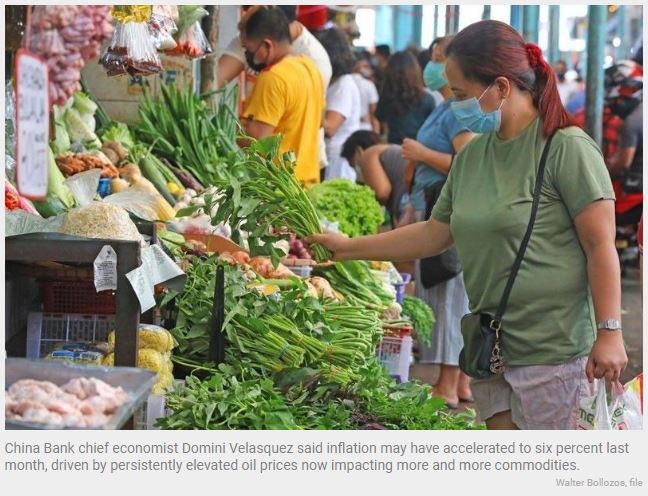Philippines: Inflation likely quickened to 6% in June
MANILA, Philippines — Most economists believe inflation likely quickened further to about six percent in June from 5.4 percent in May amid the steady rise in fuel prices, higher electricity rates and the weaker peso.
China Bank chief economist Domini Velasquez said inflation may have accelerated to six percent last month, driven by persistently elevated oil prices now impacting more and more commodities.
Velasquez said domestic pump prices increased in all four weeks in June, pushing transportation inflation higher amid the hike in minimum fares for public utility jeepneys in the National Capital Region (NCR) and nearby provinces.
Moreover, Velasquez said areas serviced by Manila Electric Co. (Meralco) experienced higher electricity prices in June as generation charges climbed.
Velasquez believes food inflation also accelerated as transport costs increased, compounded by shortages in key food items such as fish.
“Moving forward, for 2022 average inflation will likely breach BSP’s most recent projection of five percent, especially with the recent across-the-board transport hike this July, increasing costs of production, and faster food inflation,” Velasquez said.
The Sy-led bank sees inflation peaking and breaching 6.5 percent in the fourth quarter amid the gradual tightening by the Bangko Sentral ng Pilipinas (BSP).
“Despite this, monetary policy will continue to be well-paced, ending the year at 3.5 percent. There is always a possibility of BSP raising its policy rate by more than the initially planned 25 basis points in any one meeting, especially if economic growth holds up,” Velasquez said.
According to Velasquez, better-than-expected economic performance could prompt the central bank’s Monetary Board to move more aggressively.
Security Bank chief economist Robert Dan Roces said inflation likely settled at six percent, with a range of 5.8 to 6.2 percent in June as the food basket may have contributed approximately 2.3 percent, while utilities and transport each gave 1.4 percent.
“Inflation remains mostly cost-push driven, but with emergent demand-side risks. It may peak this quarter, though average for the second half could hit 5.7 to 5.8 percent,” Roces said.
As such, Roces said the BSP may consider a one-time, preemptive 50-basis-point policy rate hike on Aug. 18 if inflation’s upside risks remain persistent.
UnionBank chief economist Ruben Carlo Asuncion said inflation likely accelerated to six percent in June on rising gasoline and diesel prices, higher
electricity rates, the continued depreciation pressure on the peso as well as the upward trend of prices of basic commodities.
“A higher-than-expected inflation print this June puts the BSP on a tighter place that need to see a higher-than-expected rate hike by August,” Asuncion said as he expects inflation to peak above six percent between July and October.
ING Bank Manila senior economist Nicholas Mapa said headline inflation is seen surging to seven percent in the fourth quarter after accelerating by 0.7 percent to six percent in June, driven by faster inflation for transport, utilities and food items.
Mapa said that second round effects are also evident after wage and transport adjustments and as prices of goods and services have all gone up as firms pass on increase cost of operations.
“With both supply and demand side pressures likely persisting in the next few months, and the weaker currency stoking imported inflation, we expect headline inflation to surge to the seven percent by the fourth quarter,” Mapa said.
The Dutch financial giant is also expecting a 50- basis- point rate hike in August as the case for front-loaded rate hikes given the time delay for policy rate hike efficacy is now more apparent.
Michael Ricafort, chief economist at Rizal Commercial Banking Corp., said year-on-year inflation could still pick up after quickening to six percent in June due to the recent increase in global oil and other commodity prices amid the Russia-Ukraine war and disruptions in supply chain as a result of some lockdowns in China.
“Sources of second-round inflation effects include higher wages, hikes in transport fares that could lead to higher prices of other affected goods and services in the economy.” Ricafort said.
He said the weaker peso in recent weeks could have also added and could still add to import costs/prices and overall inflation, going forward.
On the other hand, Philippine National Bank economist Alvin Arogo said inflation quickened in June but settled below six percent at 5.7 percent, driven by persistently high prices of key commodities, such as oil.
“We see higher inflation in the second half than the first half as the second-round effects will likely be more pronounced in the succeeding months due to the increase in the country’s minimum wage,” Arogo said.
Source: https://www.philstar.com/business/2022/07/04/2192786/inflation-likely-quickened-6-june


 Thailand
Thailand




